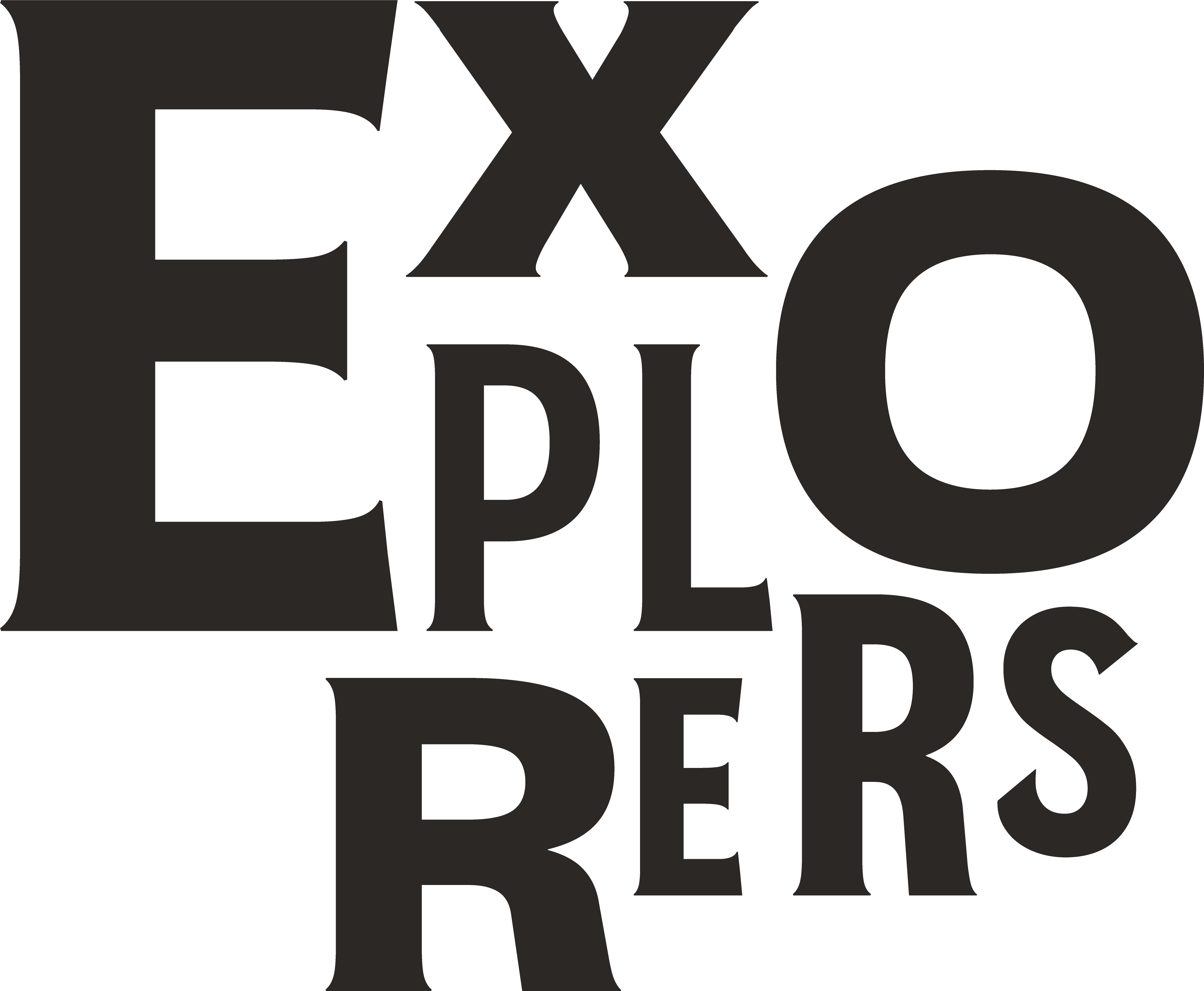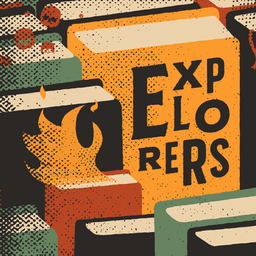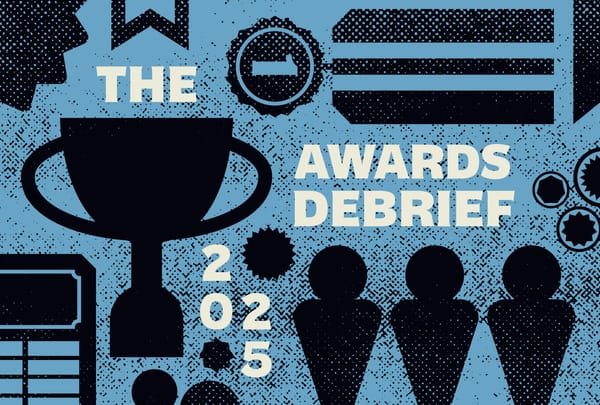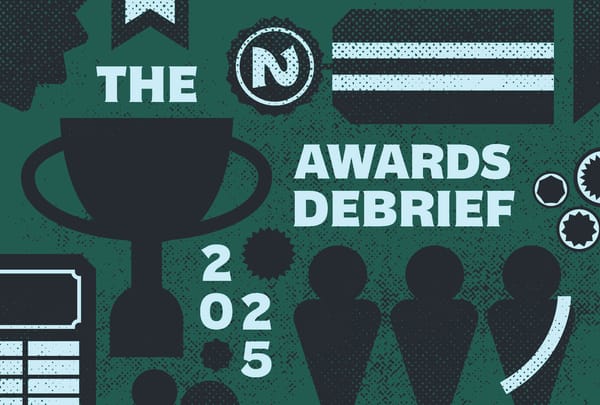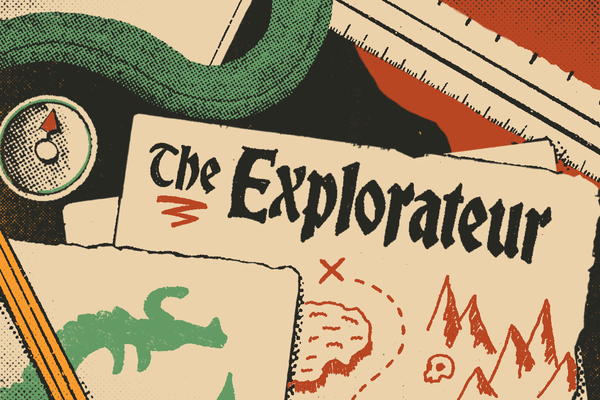How are the Ennies designed?
An insider's look into the 2025 Ennie Awards. Part three. How does the structure of the Ennies determine its outcomes? And what does it mean for others?
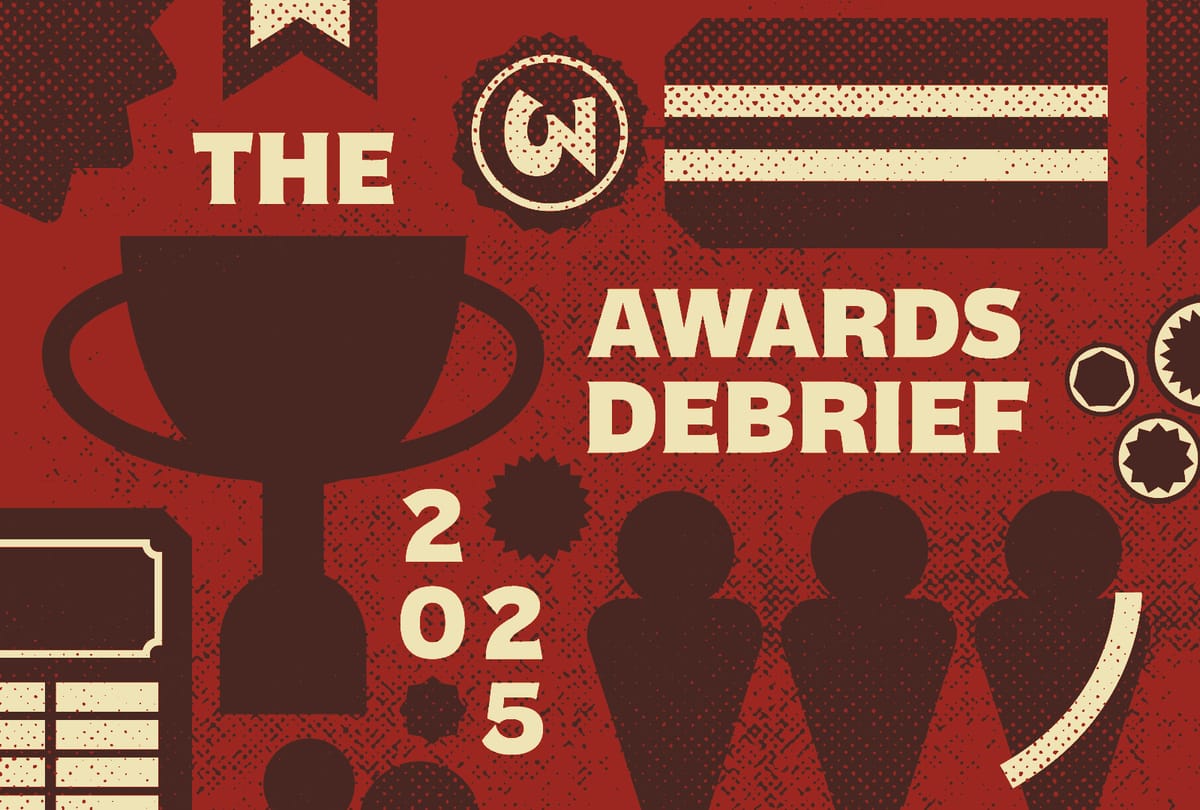
The Awards Debrief: Part 3
If you haven't read parts 1 and 2, stop what you're doing, and read those first. Part 1 established my goals and feelings about award shows—setting up expectations for the series. Part 2 gave a boots-on-the-ground tour of the Ennie Awards, how they work, and what it's like being a judge. This part—part 3—is the deep dive. Why are the Ennies like this? And what can it teach us about future rpg award shows?
The Awards Debrief
- Part 1: Why am I writing a debrief?
- Part 2: How do the Ennies work?
- Part 3: How are the Ennies designed? ← You are here.
- Part 4: Where do rpg awards go next?
Thinking of the Ennies as a system.
I've heard this analogy from several people, and can't think of a better framework for examining the Ennie Awards. The Ennies are like a roleplaying game, it has rules and procedures that create emergent "gameplay" or outcomes that aren't explicit until they're played out. In organizational design, these outcomes or results are often called consequences and they are born out of an organization's structure, processes, culture, and incentives. The reason why I like this analogy is twofold. One, I'm a giant nerd who goes to bed thinking about design. Two, it creates a physical link between what an organization does and how it's designed to act. It separates individuals from that system, because an institution that is designed to produce unfavorable consequences will do so regardless of who is in charge. (Though it is ultimately up to individuals if they want to change the system.)
For many, myself included, the Ennies' outcomes are unsatisfying but tantalizingly so. Most years, I'm frustrated, confused, or numb to its presentation, nominees, and winners. I don't like how unorganized it feels. I don't like how scrappy it looks. And I don't like how nominations often lead to outrage on social and very few conversations beyond that. It's this dissatisfaction that led me and many of my friends, to ask, "What could we change about the Ennies to make it produce the results we like?" Or to put it another way, "If the Ennies is our game, how would we redesign it to produce the gameplay we like?"
But I've learned something in my attempts to answer those questions. They make two assumptions that are not true.
The Ennies is not our game. And the Ennies is not designed.
The Ennies are not everyone's game.
After years on the outside, and a year inside, I've realized I'm like a euro-style board gamer trying to fix party games. What gives the Ennie Awards its shape belongs to a specific time and place. A world I have no relationship to. I've never been an EN World community member (which originally ran the Ennies), I was never part of the D&D forum culture of the early 2000s, and I didn't grow up with game stores and conventions. The Ennies belongs to a subculture and category of awards that I don't identify with. I don't like people's choice awards, zero-sum winners, or thinking of rpgs as something singular—but that's what Ennies exists to uphold.
That means this article can't "fix" the Ennies no more than a train enthusiast can fix cars. (And god, do I wish I could fix cars.) The bugs are features. I'll still be proposing some changes, because I love design as an exercise, but my goal isn't to fix the Ennies, it's to show the pitfalls when building an alternative.
The Ennies are not designed.
The Ennie Awards are not designed. Not in the way designers or organizational designers might define it—holistically and systematically. Most of its processes and subsystems are not deliberate. And I'm not rendering a strict value judgement on the Ennies by saying this. Most organizations are not designed. Especially organizations born out of hobby spaces with no real money or resources.
The Ennies is an ongoing project that started in 2001, changed hands in 2018, and evolved naturally as it went—often in pieces in reaction to industry trends and public outcry. This means many systems are inherited and layered on top of each other like patches on a video game. While judging, I sensed the existential question was always, "How do we keep this thing going?" And, "How do we uphold our history?" Which are not bad questions to have, but it does make change conservative at best. Yet, I have to admit, it's likely why the Ennies have lasted so long. Many of its critics are probably asking what and why. "What actually are the Ennies? Why do these systems (processes, categories, voting, ceremony) work this way? What do they produce? And why does it matter?" Asking questions like this makes the Ennies appear systematically incoherent, which it absolutely is, but it pressures the project to have been designed from the ground up when it never was.
The Ennies are in a stalemate with its legacy. Many of its bugs are legacy. What critics want to change, many fans want to remain untouched.
How the Ennies are designed.
The table is set. Now that everyone the same foundation of knowledge, we can ask the real question: what are the Ennies' designs, and why does it matter?
Let's explore (!) the Ennies one subsystem at a time.
#1 The challenges with publicly elected judges.
Before we get into it: I liked my fellow judges. They're good people. Rabidly curious, naturally earnest, and pretty dang funny. We definitely didn't see eye-to-eye about certain things, like what constitutes "excellent," but we were always working toward the same goal.
The diversity problem. The problem with publicly elected judges is that it leaves the entire enterprise to social bias. And society, especially tabletop roleplaying games, favors white men. You know how it works. The Ennies, by virtue of its position, helps reinforce or change the culture. That's partly why award shows are important whether we like them or not. They create the canon an artform grapples with. By having the judges self-nominate and run in an election, the system empowers those who already have momentum. This year's panel was white and American. Only one judge was a woman. It was a disservice to everyone (the public, judges, and Ennies) to represent an industry with only a fraction of the required perspectives. Something should be disrupting the pattern of inequality, and the first thing that should do it is the system itself. By not hand selecting the nominees or building in a step that winnows down the applicants, the Ennies forces itself to play whatever cards it's dealt. In my opinion, award shows should be stacking the deck when selecting judges, and there's a way to do it without making showrunners feel like they're cheating.
The influencer problem. Judges need an audience to get voted in, which means influencers have the advantage when it comes to judge seats. It doesn't have to be a big audience either. (My small audience got me in.) All a candidate needs is the "right" credentials (more on that later) and enough fans to win. The problem is that particularly big influencers don't reflect the industry, because influencers are not decided by the industry, they're decided by algorithms. Online, popularity is dominated by economics. Which is why many years over-index in D&D, Call of Cthulhu, and AP-friendly play cultures. These are not inherently bad results, especially if the Ennies are a big box rpg award show. But if the system is going to naturally favor influencers, it's going to crown the influencers bigger than all the other influencers combined.
The brigading problem. Despite everything I've listed above. There's another issue. Public elections can be manipulated. It's not impossible for a subculture to "raid" the online voting booth, install their judges, and sweep the Ennies. Everyone is trying to do this a little bit. You want your friends and favorite games to win, so you hop online and tell everyone you know to vote for your corner of the industry. But what happens when it becomes political? We already know the alt-right exists in rpgs, and we know their favorite tool was invented nearby with Gamergate, so how long before the bots and bad actors decide to go on the offensive? It's a ticking time bomb with no one to stop it before it goes off. I've raised this concern very casually in judges' meetings, thinking some of the coordinators might nibble at it. The problem is that for many it's a question of if when I think it's a question of when. If everything remains the same, the Ennies are going to continue to grow, and the bigger and more influential it gets, the more it draws the attention of people who want to co-opt it.
#2 The consequences of the Judges' NDA.
Just to be clear, there's nothing wrong with award shows requiring NDAs. The process should be private. It's the best way to protect everyone involved and keep social media from mucking things up. The problem I have with the Ennies' NDA, is that it goes too far and effectively prohibits worthwhile candidates.
One of the stipulations of the NDA is that you can't have any communication with potential submitters, which is hard when the applications window is ongoing—so everyone is Schrödinger's nominee (congratulations). Obviously, being a consummate Chatty Cathy, I wanted permission to drop a few pre-written messages on Discord channels and social media. The coordinators were nice enough to let me do that, but it felt like they were incredibly uncomfortable by the idea. We had strict rules that we couldn't invite people to submit, so instead we gave the coordinators a wishlist of games and creators to reach out to, and I'm not sure they were entirely successful in that outreach. After all, it's not easy contacting some creators unless you already have a pre-existing relationship.
The limited judge types. From the judges' code of conduct and NDA: "[Judges must] not have any professional relationship with any RPG publisher during the period, six months prior, and 12 months post becoming a judge." This effectively limits conflicts of interest (an inextricable part of award shows), but it bars the most ideal candidates from being judge. Designers, artists, publishers, and reviewers are exactly the kinds of people we want judging their peers. But it's not realistic for working professionals and hobbyists to cut ties with the companies and people they need to create games. They need professional relationships to make roleplaying games. Pair this policy with the Ennies' public voting challenges, and we have a volatile combination. The more experience and perspective a person has, the less qualified they are to be judge.
I think trying to eliminate conflicts exposes a fundamental misunderstanding of how award shows work. Judges with conflicts of interest have them because they're qualified, and the more connected they are, the more valuable they are to the project. Judges with prominent roles in the industry make artists want to apply and make knowledgable community members (the super fans) pay attention. Conflicts of interest are good. We don't want to find people who don't have them, we want to create systems that allow them to dip in and out of the conversation.
#3 The cost of accepting physical submissions.
The cost of shipping physical submissions is immense. Literally and figuratively. Shipping to my house must have cost everyone collectively over 10k USD, and I'm one of five judges. I don't know how the Ennies plans to continue with Trump's trade policies. The cost of duties, taxes, and shipping in and out of Europe was already exclusionary—now the burden is being felt by everyone.
International judges aren't feasible. When the judges were announced in August of my year, only four of them ended up being judges in 2025. The fifth, a woman living in Europe, had to bow out because the burden of duties and tariffs had to be paid out of pocket. The Ennies wouldn't pay it (and probably can't afford it). I'm not naming her because I want to respect her privacy, but we're colleagues, and I was infuriated when I found out. The Ennies team has since updated the website, but I think it needs to be clearer and more obvious. The cost of the first shipment from Gen Con alone would have cost her over $500. The total cost for an entire year would have been astronomical. I don't see any realistic way for someone to be judge outside of United States. With this year's tariffs, it may become economically unfeasible for judges within the United States. This is why even in large industries, award shows are still semi-regional. People from all over the world can participate in London's design awards or America's Type Directors Club, but they're still explicitly based in those countries.
Tracking shipping is proverbial hell. The Ennies have accomplished an extraordinary task coordinating and confirming shipments, but it's a full time job with constant room for error. I keep thinking there has to be a better way than online forms and a Google Sheets database, but those solutions probably cost a lot of money and still don't solve the other issue which is that judges have to provide their home address to strangers. It's a weird rpg-specific problem. In design and advertising, work can be consumed and judged over the course of a weekend at a conference. In movies and television, you can send logins to online portals or trust rich studios to figure it out. Rpgs are different. They take months to read, review, and deliberate on and there's a lot more people participating. Then there's the fact submissions pour in over the course of months. There's never really an off-season for the Ennies. As soon as one show ends the next year's begins.
#4 What the Ennies' loses by using Facebook.
Nothing prepared me for the moment I learned we use Facebook. It's still a massively popular platform in some countries, it's almost like infrastructure, but in the US, it has fallen out of favor with a lot of people, myself included. I hadn't used Facebook in years, on account of Meta... empowering hate groups, fueling the alt-right pipeline, helping militia groups organize and recruit new members, stealing all of our data, falsifying video analytics, selling our data to foreign intelligence groups, fueling anti-vax conspiracies, selling our phone numbers to telemarketers, Q-Anon, January 6th, MAHA, Sweet Baby Rays... you get the picture.
If we ignore all the scandals, we're still left with a more pressing problem—Facebook's not designed for long and linear discussion.
It was one of the first things I brought up in our inaugural judges' meeting. Can we use Discord, Slack, or something else instead of Facebook? The answer was no. Not right away. There was some discussion. Some exasperated explanations. A show of hands. Some willingness from judges to try it out. But it never happened. We used Facebook for announcements, messenger for discussion, and Zoom for everything else. The argument? Changing platforms would require folks to learn a new platform and risk being left behind. "Facebook just works better in our experience." (Which I wanted to interrogate and still do.) In the end, the discussion died because it felt a little heated. I felt like the question was met with indignation—like it was an insult—and I didn't want to start on the wrong foot. I knew I was coming in hot with lots of ideas. So, rather than cause a stink, I shifted to listening, and was told if I really wanted to write my thoughts on all the entries, I could do it in Google Docs and share it in Messenger (which sounded like a great way to become the group's resident maniac).
So, we used Facebook, Messenger, and Zoom—and the process warped around it. The way social media warps all conversations. You know what Facebook doesn't do? It never leaves anything alone. Even with my new profile, it pinged me over a dozen times a day—burying important notifications with nonsense drek you can't turn off. It shuffles unpinned posts, like meeting times and questions. Pop-up ads for zinc supplements and pink glocks clog the feed. Messenger devolves into group chat without threading, tagging, modding, or adequate search. Least of all, the UX is just loud. The app wants you to play games, buy beanie babies, storm the capitol, and watch this clip from the Joe Rogan experience.
Facebook successfully drove any long form discussion from me into Zoom, which meant a lot of our deliberations were never in writing. It was all ephemeral, which meant if we didn't keep our own notes, a lot of thoughts, suggestions, and questions disappeared into the clouds where login passwords, important dates, and my car keys go. Our tools shape our interactions. By not having tools and platforms to share and record our thoughts in long form, we risked making mistakes, mis-communicating, and losing opportunities.
#5 The Catch-22 of 1000+ entries.
If the judges want to meet the spring deadline, they have to read, review, and debate submissions as they come in. That means assessing everything one-by-one while keeping a private running tally of what's up to snuff and what isn't. But here's the real problem: we had to do that with 1000+ entries, and for most of the year, hundreds of those entries are still on the way.
The problem is counter-intuitive. When you have a 1000 books to judge, you actually want them all at once. Getting them one at a time leaves you few examples to compare with, which means you can't budget your time or make fair comparisons without doing lots of redundant work. Everything is up for consideration when you don't have everything, even the things that are definitely not going to be nominated. In an ideal world, the schedule would be flipped—with most of the time being after the deadline instead of before. But that's not possible with the Ennies timeline and year-long submissions window. So, we had to treat judging like a marathon.
No system of review for 1000+ entries. In part 2, I mentioned we didn't have any rubric or scoring system. I think this is a good design decision. The best entries always have intangible qualities that slip past standard grading rubrics. The more something resembles art, the harder it is to grade on a 1-10 scale. So, I'm anti-score card. I know from experience they don't result in compelling nominations. But I'm not anti-system. My proposal was that we maintain a shared shortlist. A qualitative list that keeps even the smallest curiosity on everyone's radar. That way we could examine entries as they come in without losing track of the standouts for conversation (or feeling the need to self limit)—but that's not part of the Ennies process or culture, so it didn't get any traction until I shared the spreadsheet and proposed it again in February. By March, it was replaced by the spreadsheet I described in part 2 (the one with 7 entries per category) but by then we were halfway through March.
Pdfs put pressure on tools and processes. One of the things that showcased the limitations of the Ennies infrastructure were pdfs. They were in Google Drive, which meant I couldn't download them as zips without Google giving me seven zips with 1/7th of every submitter's folder. Not to mention it would crash and stall out often. Worst still, because designers and companies submit pdfs throughout the year, we had to constantly backtrack and re-browse every folder (almost a hundred of them) to find the latest submissions recorded on the Ennies spreadsheet. It was tedious, stressful, and wasteful when we needed more time to read, review, and talk.
It'll be expensive, but award shows need user friendly processes for storing and tracking submissions. The Awards used Dropbox, Discord, and running lists the year I judged, and I felt their absence. Similarly, in advertising, we actually limit entries to very specific formats and parameters. It's a pain for the submitters, but moves the legwork to the correct side of the relationship. An award show's job is compare entries from across the industry. It's the submitters job to compare the entries within their own catalog.
The problem escalates. The other challenge with the Ennies' submissions happens to be unique to tabletop roleplaying games. There are no filters explicit or implicit on the submissions. No incentives to self-select, no vetting process, and nothing keeping everyone from flooding the Ennies with entries. Companies send their whole year's catalog including dice, miniature bases, and booster packs. Indie designers send everything from ashcans to misprints. And who can blame them? The Ennies accept and consider everything and filling out the form is free and very, very, very easy. (You don't even have to write down the credits when you enter.)
This is a consequence of the Ennies design and its increasing popularity. Award shows outside of rpgs tend to have systems that dissuade unserious candidates from applying. They also impose explicit rules and procedures that throttle or cap the number of entries that end up in front of the judges. It sounds unfair, but most of the rules only turn away applicants who abuse the system and crowd out other people's work. Submissions that are filed wrong are sent back. Entries that leave most of the form blank don't get processed. Some award shows even require references, endorsements, or membership in an organization.
I bring this up because the entries will increase as the show expands. That means the judging process will get harder the better (and more popular) the Ennies become. And they are getting bigger and better every year, but it's an inverse relationship with unsustainable results.
#6 The unordered categories creates disorder.
It's atypical for submissions to be sorted by judges. In movie, video game, and graphic design awards, the burden is on applicants to decide what categories their work belongs. If they think their work belongs in multiple categories, they fill out the form multiple times. A tiny dram of tedium to make submitters ask themselves, "Do I really think my dice have a shot at best writing?"
Judge sorting makes it harder to judge. Right now, the Ennies process puts the burden of sorting on the judges. Which makes deciding on nominations that much harder. After all, evaluating 1000+ entries will give you a headache, but evaluating 1000+ entries and sorting them into 21 categories will give you a nosebleed. We spent a lot of time and energy debating what entries belonged where. "Does the submitter think this product is a campaign or an adventure? Is this product an adventure or a capsule game?" You can drive yourself batty trying to read between the lines. And then there's the fact that by making the judges sort the entries, the system is also making the judges try to balance game and community representation across said categories.
Alphabetical order is disorder. This sounds inconsequential but I promise it isn't. People tend to think of things in groups and orders of hierarchy. The Ennies categories don't do that. They're arranged alphabetically. Which means you get categories like best adventure and play aid (which are products) interrupted by best art and best cartography (which are qualities and components of products). This jumble means I constantly reshuffled the categories in my head. Eventually I print out a reordered list so I could compare submissions against it. But the alphabetical order doesn't just have tiny consequences for judges.
The alphabetical order also creates confusion in the community at large, especially during the ceremony when best product ends the Ennies like it's best picture at the Oscars. Systems create meaning. The alphabetical order suggests intentionality, but its arbitrary arrangement is sending the wrong message.
The categories have weird names. Alphabetical order creates this little quirk with some of the category names. It's silly, but "Best Aid/Accessory - Digital" is a goofy name. Clearly written so it can sit next to "Best Aid/Accessory - Non-Digital." It forgoes natural language for something clunky. It's not important in the grand scheme of things, but you would never write that on a medal unless you felt obligated to, which is exactly how subtle some systems create outcomes.
#7 Categories are designed unevenly.
Most of the categories are self-explanatory. Still really hard to judge, but not confusing or misleading the way other categories are. The thing about the Ennies and its categories is that some are open to interpretation, and others are not, and it's not obvious which are which until you're a judge trying to fill them in.
Best Family Game. There are three ways you can define this category—games for "kids," games that are family-friendly, and games that play with family themes. Every year people get upset when a game is nominated in this category, because they interpret it as an insult—like a worse version of Best Game or the judges labeling a game the Coco Melon of rpgs. Here's what happened my year. We had more award-worthy games than seats in Best Game and Best Family Game combined. Many of these award-worthy games were family friendly or had themes in common with family movies and literature. (Think: Yazeba's Bed and Breakfast and its themes around found family, growing up, grief, and more.)
In our year, we made the executive decision that Best Family Game and Best Game were on equal footing (especially since the categories are unordered). In effect, Best Game became a category for great games that were not family friendly or particularly interested in those themes.
Some people think this category should be for the baby games, which I think underestimates kids and what family-friendly material can be. Inside Out is a family movie. Zelda is a family game series. The Hobbit is a family book. None of those are strictly for little kids, which is why Land of Eem can be a family game, without dumbing anything down or stripping it of the same things adults like.
The point is, the Ennies leaves this conundrum up to the judges to figure out. I think we made the right choice. Maybe in previous years, Best Family Game was supposed to be for the Peppa Pig cash grabs and the Carved in Blue's Clues hacks, but that the coordinators gave us a lot of wiggle room to decide what we thought was best and most reflective of that year's submissions.
Best Community Content. This category is surprisingly not as flexible as it appears. The website says this: "Formerly known as Best Organized Play, this category is awarded to the best adventures created to support community content programs such as Organized Play (OP), either by the company owning the Intellectual Property (IP) or those given open permission to do so by said company, community content programs, or by a third party commissioned to do so." Based on this definition, it seems like maybe 3rd party content is eligible, like the kind made for Pirate Borg, Shadowdark, Trophy, and DCC. Many of those games and products end up in play at conventions.
Unfortunately, that's not the case, and the reason is a little more complicated than you'd expect. The key phrase here is, "Formerly known as Best Organized Play..." This category is a holdover from when D&D and other games had popular weekly events in game stores. Back then, Organized Play was a lot more common and heavily structured and controlled. It's what DriveThruRPG's content programs for D&D, Pathfinder, Call of Cthulhu, and others originally serviced. And that is what is still eligible in this category. If your submission are not made and distributed through that platform, it's not eligible for Best Community Content. At least that's how I remember it being conveyed to me.
This weird disconnect is a great example of how the Ennies are designed with a specific audience in mind despite being a broad award show. It's also a great example of how the small evolutionary changes can create confusion. My definition of Community Content and the Ennies' definition are not the same. I was tenacious about this category changing, because I thought my interpretation was more in line with the public's, but it would have made the category a lot more competitive. If you look at DriveThruRPG's community content page, you'll see what my alternative interpretation would have done to the communities protected by the current interpretation. It's messy.
#8 The bigger you are the bigger the problems.
Most rpg award shows try to represent the rpgs in its entirety, and I think that puts too much pressure on all of them. The industry is economically small but culturally massive. Not even the Academy Awards represents all of cinema. They conspicuously omit horror, comedy, and action movies unless they're period pieces or shot by Roger Deakins. Never mind the fact that the rest of the world also makes movies, and they're conspicuously missing as well.
Expanding to all rpgs sets impossible expectations. The first two parts of this series were all about table setting, and that's because I didn't want people to be disappointed, surprised, or misinterpret what I said. When the Ennies advertises itself as excellence in all of rpg gaming, it puts them in a boss fight they can't win. Every community expects different things and defines them in different ways. "Excellence" in writing is already a subjective idea between two Starfinder players. It might as well be a different language between a Mörk Borg sicko and Runequest dork (I'm bilingual).
The industry is expanding faster than any award show. In just five years, solo games, capsule games, and hundreds of other genres have come and gone without the Ennies' categories changing hardly at all. That's not the fault of the Ennies. If every year had new categories, the Ennies as we know it would lose all meaning. (Though I'm interested to see what the amorphous award show looks like.) The point is, these changes come quick when your scope is big. One small change or innovation in any subculture becomes overwhelming when there are dozens of them. The awards that don't limit themselves are always going to be behind.
Judging content creators is unsustainable. It's already hard judging and comparing different kinds of games, genres, and play cultures. Best Online Content and Best Streaming Content requires entirely different skill sets. It's not just about the content, it's about the editing, the writing, the performances, and the context around the creators. You could make an entire award show's worth of categories just for content creators (which the Crit Awards are trying to do). Content is always going to be second fiddle to rpgs in the Ennie Awards. Judging these categories requires different knowledge and expertise. I happen to really like blogs, but most judges don't. The Ennies will be hard pressed to find judges whose interests are as broad as the Ennies categories. That's why I think they should just rip the band aid clean off and focus on the categories they have resources for.
The Ennies is not designed for all rpgs. We tried very hard to represent as many rpgs as we can, but the Ennies are not a universal award show. Many of its categories originate from when the industry was smaller and less complicated. Today, they betray a systemic preference for certain rules and play cultures. Best Adventure, for example, probably wouldn't be a category in an award show dominated by solo games. The Ennies might be system and scene agnostic, but its infrastructure isn't. The Ennies used to be dominated by d20 games and classics like Call of Cthulhu, and you can still see that DNA in its categories, culture, and processes.
What do we do with these designs?
It's easy to look at these dilemmas—some of them existential threats to the Ennies—and see doom. But I see the opposite. If an award show's design can create problems, it can also fix them. That's the cool realization I had while judging. The problems are not abstract puzzles with impossible solutions. They're surprisingly tangible. Make one small change to the system and the gameplay changes instantly.
The question is, "Do the Ennies want to change?" I don't think they do. And, more importantly, maybe they shouldn't be expected to. I think a lot of us want an industry award, and see the Ennies' size and popularity as a wasted opportunity, but the Ennies is not that kind of organization. It's always been a fan-based celebration. It doesn't have the vision or thrust in its structure to be anything but a fan-based celebration. No goals to shake things up. Which means it's always going to be behind on things like AI, representation, and innovation. The kind of things an industry and craft award cares about.
Believe it or not, though, I still enjoy the Ennies. I don't necessarily like them as our industry's biggest and most "important" award show. In that role, it's not for me, the same way horror movies and Gundam aren't. An award show is defined by its systems, processes, incentives, and culture. Which has me asking, "What's next?" If we could design an award show from the ground up, with all of our learnings from other award shows—including the Ennies—where do they go next?
Continue reading...
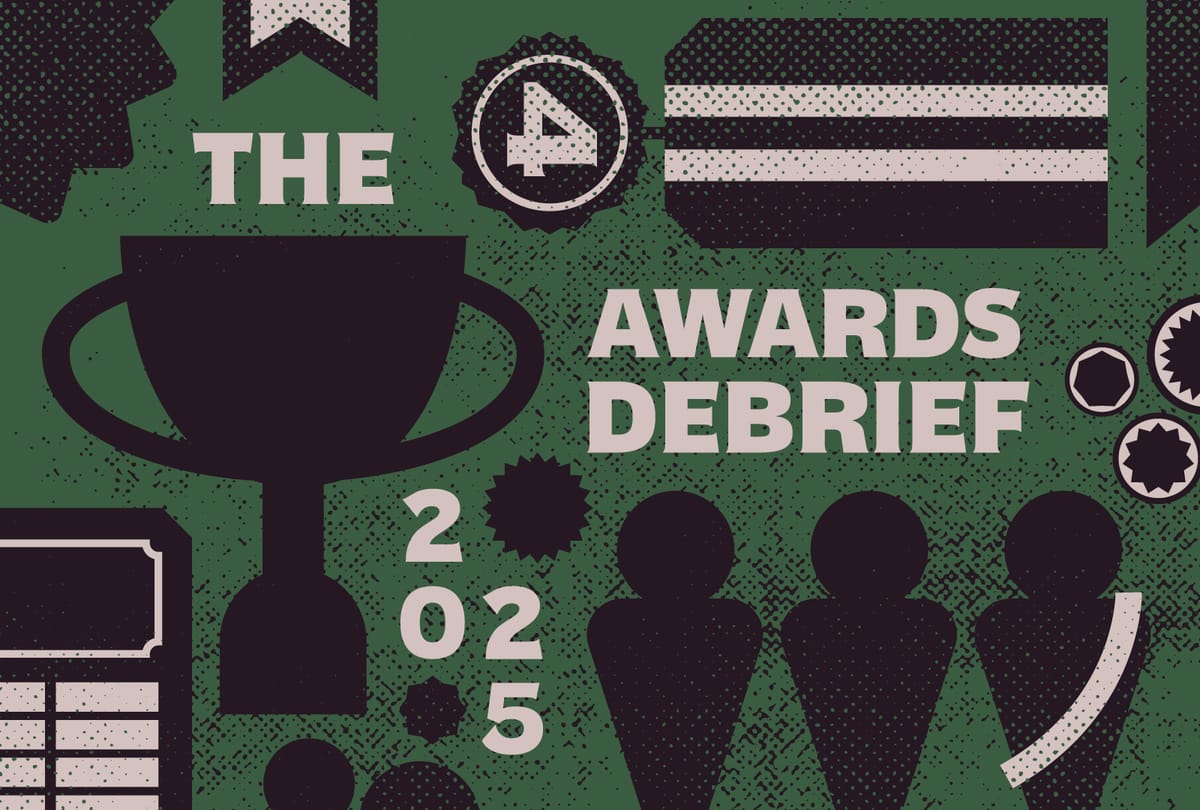
This article will unlock October 9 or 10th.
